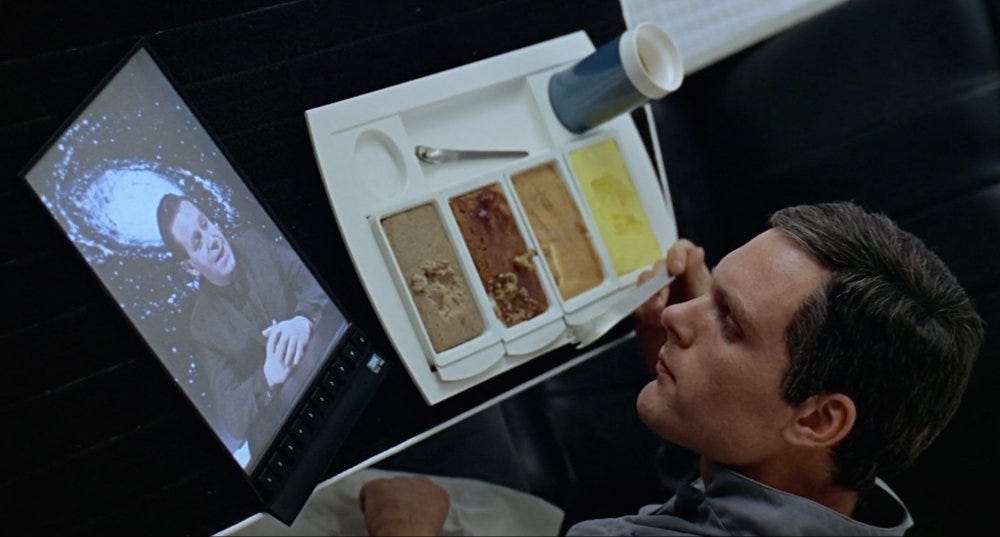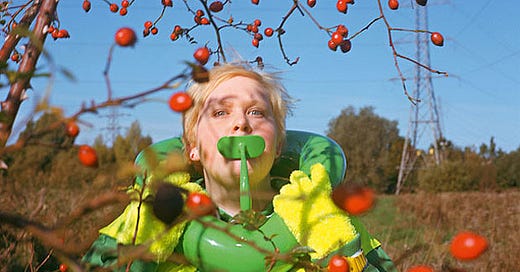This week’s Design Lobster is in a speculative mood 🤔 We’re exploring the concept of design fiction and its ability to blow our thinking wide open. We’ll be hearing from the legendary Bruce Sterling and examining some freaky examples of fictional human augmentation by duo Dunne and Raby 🤖
An especially warm welcome to the 150+ of you who’ve joined since the last issue, it’s great to have you here!
✨Enjoying Design Lobster? Please share it with a friend, colleague or fellow designer.
Question: What is design fiction?

Design fiction or Speculative design is a design practice that explores potential futures by designing functional objects that would be used in them. These artefacts bring those future worlds to life in a more visceral way and thus enable a higher quality of debate about the future that we want to build. In the words of one of the founders of the practice, Bruce Sterling:
It’s the deliberate use of diegetic prototypes to suspend disbelief about change. That’s the best definition we’ve come up with. The important word there is diegetic. It means you’re thinking very seriously about potential objects and services and trying to get people to concentrate on those rather than entire worlds or political trends or geopolitical strategies. It’s not a kind of fiction. It’s a kind of design. It tells worlds rather than stories.
—Bruce Sterling, in conversation with Torie Bosch
I recently watched a panel hosted by the ASU Center for Science and the Imagination that explored the topic in detail. They emphasised the way fictional artefacts can create much deeper emotional engagement with ideas than more conventional concept videos. The panel also cheekily pointed out how many ‘fictions’ there are out there already which we don’t realise – sober business artefacts like financial models for example are really a kind of fiction, projection and hope. Something perhaps worth reminding your company finance department of from time to time 😉
Design takeaway: Could you make progress with your project with a piece of design fiction?
🗜 We admired a cyberpunk lamp designed by Bruce Sterling in Design Lobster #79
Object: Foragers

Over the weekend I went to an exhibition of Surrealist design at the Design Museum here in London with my friend Yulia. Among the objects on display were four rather sinister metal objects by design duo Dunne and Raby, all painted in vibrant green. Designed in 2011, the objects explore a future world where overpopulation has lead to food insecurity. To adapt, humans have not attempted to increase production of conventional foods but have instead engineered themselves in order to consume things that were not edible to us before.
We were interested in this idea that rather than changing the environment we should begin to change ourselves
—Stephen Dunne
The different Forager objects allow humans to graze and digest trees, weeds and even algae growing on the surface of water. A thrifty, if rather bleak vision of the future of human life on Earth.

There was something about being in the presence of these objects in a museum setting that was really quite unsettling – as if that imagined future had somehow already happened. Having felt its power, I’m excited by the potential for this kind of design to bring to life other debates too.
Design takeaway: How might you transport people viscerally into the future you’re building?
🪑 In Design Lobster #4 we looked at an extra-sensory chair designed by Dunne and Raby
Quote: “Fiction reveals truths that reality obscures.”
– Jessamyn West, writer
Jessamyn West was a 20th century novelist, whose most famous book The Friendly Persuasion was published in 1945. Her quote reminds us that there are some things we can only learn when we exercise our imaginations. As designers, we often make progress when we are able to leave reality to one side for a little while.
Have an imaginative week,
Ben 🦞
PS. If you’re interested in what I’ve been designing lately, this tweet thread gives a peek at some recent work 👀
Enjoyed this week’s Design Lobster? Let me know by clicking the heart button ❤️
👇




Human augmentation already exists with prosthetics and human computer interface, the most recent not requiring any form of surgery. SciFi is rapidly become fact, with DARPA and others like Rex Bionics working closely on tech for military and for the disabled. I had a play on this space in my blog at The Future Diaries, thinking about world games for people with augmented tech.
You are really onto something here. The need for design to illustrate the broad patterns of what is happening and what has been hidden is critical. Not much of a fan of surrealism for this although it is an important part of our information.